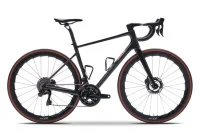Press Fit Bottom Brackets
A version![]() of this article was originally
of this article was originally
published in Triathlete Magazine
Press Fit Bottom Bracket Technology
What are the advantages/drawbacks of the new “press-fit” bottom brackets and cranks? Which “press fit” size is the best and can a current bike be converted?
Ted
Hi Ted,
First a brief history – “Press-fit”, or “Integrated”, bottom brackets were actually introduced decades ago in BMX, but have taken some time to be refined to the point where they work universally well in multi-gear applications. The first integrated bottom bracket designs in multi-speed bikes that I remember were in the early 1990’s when Gary Fisher, Klein and Merlin all offered bikes with threadless bottom bracket shells. These designs used cartridge bearings that were pressed around the bottom bracket spindle and were held in place with metal circlips. In addition to being a chore to service, the biggest limitation of these designs was that they were only compatible with the square taper spindle cranks that were popular at the time. As improvements in bottom bracket/crank design were released, these early integrated bottom bracket frames became obsolete as they were simply not compatible.
One other company was working on integrated designs in the early 1990’s and that was Cannondale. However, Cannondale was not just looking to replace cone and cup bottom bracket bearings with cartridge bearings like the others, they wanted to reduce weight and increase the stiffness of the entire crank and bottom bracket system. Instead of focusing on the frame, Cannondale initially focused on developing an integrated spindle crank that used externally mounted bottom bracket bearings. By mounting the bearings externally, the restrictions placed on spindle size by the bottom bracket shell were significantly reduced and larger diameter bearings and crank spindles could be used. The result was a crank and bottom bracket system with significantly lower weight and greater stiffness than most anything else at the time. While the initial Cannondale crank designs had some compromises, Cannondale continued to develop the idea and, in the year 2000, they introduced “SI” (System Integrated). “SI” took the crank and bottom bracket concept one step further by adding the frame into the system – what we now know as a “press-fit” frame was born. Cannondale offered the new design as an international standard – available to any frame manufacturer that wanted to use it at no cost – and named it “BB30” after the 30mm diameter of the crank spindle.
Despite the weight and stiffness benefits, few frame manufacturers jumped on “BB30” initially – primarily because the only crank that worked with it at the time was Cannondale’s. However, this would all change when Shimano introduced their Hollowtech II crank design for the 2004 season. While Shimano did not (and to this day, does not) offer a BB30 specific crank and bottom bracket (Shimano’s integrated spindles are 24mm in diameter), the adoption of an integrated spindle/external bearing crank design by the largest manufacturer of components on earth made it clear to the industry that integrated spindle cranks were here to stay. Once integrated spindle cranks became “the norm” for big crank producers like Shimano, SRAM, FSA and Campagnolo, manufacturers started to explore the concept of press-fit bearing frames more actively.
While integrated bottom brackets are not the standard yet, you will see more and more of them each year. Big bike manufacturers (Trek, Specialized, Giant…) have put integrated bottom brackets into some of their frames over the past few years while specialty builders like Parlee and Guru now offer BB30 in some models as well. There will likely never be a universal standard for press-fit frames (Trek uses their own 90mm wide bottom bracket shell they call “BB90” in some road models, Giant and Scott’s press-fit road options use a standard developed with Shimano called “BB83”…). However, while it is a good idea to check compatibility and adapter options if you want to use a specific crank and frame together before you buy, the relative simplicity of the press-fit design means that most press-fit frames will work with a wide variety of cranks.
Can you convert an existing bike with a threaded bottom bracket to press-fit? No. However, you can still take advantage of some of the benefits the concept has produced. Modern external bearings cranks, whether used in a press-fit or threaded frame, offer many weight and stiffness benefits compared to earlier designs. Also, if you want to use an over-sized BB30 axle in your threaded frame, Zipp offers ultra-thin walled threaded cups with their light and stiff 30mm spindle equipped VumaQuad and VumaChrono cranks. Of course, for those with a press-fit frame, Zipp offers BB30 adapters too.
I would not use integrated bottom bracket design as a criteria for buying or not buying a frame or bike at this point – there are other far more important variables (fit and ride quality, to name just two). But, as press-fit designs become more refined and solid, you will see more and more frames that use it. Like the threadless headset, press-fit bottom brackets do the same job as threaded, but are lighter, simpler, stiffer and cheaper to produce.
Ride hard and smart.
Ian









